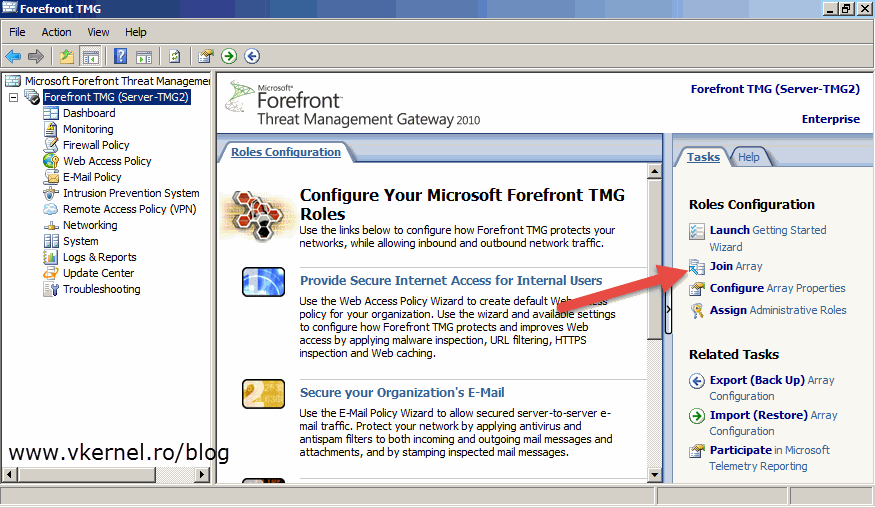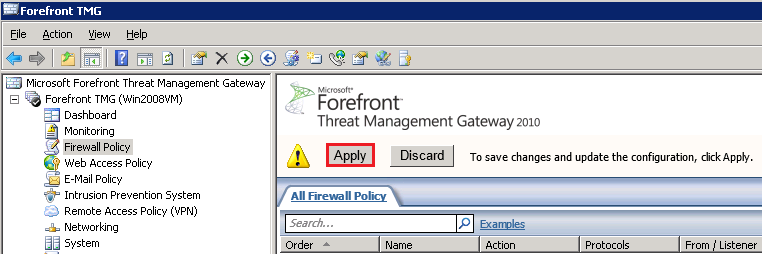
- #Microsoft forefront tmg 2010 update#
- #Microsoft forefront tmg 2010 Patch#
- #Microsoft forefront tmg 2010 windows#
Under each of these keys create new keys called Client and Server. To do this, open the registry and navigate to HKLM\System\CurrentControlSet\Control\SecurityProviders\SChannel\Protocols and create two new keys called TLS 1.1 and TLS 1.2. It’s also a good idea to enable new protocols such as Transport Layer Security (TLS) v1.1 and v1.2 for modern clients that support them. Restart the TMG firewall for this change to take effect. To do this, open the registry, navigate to HKLM\System\CurrentControlSet\Control\SecurityProviders\SChannel\ and create a new DWORD value called DisableRenegoOnServer set to 1. To prevent denial-of-service (DoS) attacks, it’s a good idea to disable client-initiated SSL renegotiation. Restart the TMG firewall for this change to take effect.Īt this point, running the SSL server test again will now yield an A rating.įigure 4 Additional SSL Security EnhancementsĪlthough the changes we’ve so far have significantly improved our security rating, there are a few more things that should be addressed in order to provide the highest level of security for our SSL published web sites. To do this, open the registry, navigate to HKLM\System\CurrentControlSet\Control\SecurityProviders\SChannel\ and create a new DWORD value called AllowInsecureRenegoClients set to 0.
#Microsoft forefront tmg 2010 update#
Even with the update installed, it will be necessary change SChannel’s mode from compatible to strict. Since this security update is now more than three years old, it should already be installed on your TMG firewall (if it is not, you probably have bigger security issues than just weakly protected SSL published web sites!). To address the insecure renegotiation issue, security update MS10-049 must first be installed. Under the Server key create a DWORD value called Enabled set to 0. To do this, open the registry, navigate to HKLM\System\CurrentControlSet\Control\SecurityProviders\SChannel\Protocols\SSL 2.0 and create a new key called Server. The first step in improving the security of published SSL websites with Forefront TMG is to disable the use of SSL v2. All of these issues need to be addressed before allowing access to Forefront TMG published SSL web sites. It is also susceptible to denial-of-service (DoS) attacks as it supports client-initiated renegotiation. It is also vulnerable to man-in-the-middle (MitM) attacks because it supports insecure SSL renegotiation.
#Microsoft forefront tmg 2010 windows#
For example, by default Windows Server 2008 R2 supports SSL v2, which is very insecure and should not be used at all. To be fair, this is no particular fault of Forefront TMG, as TMG simply leverages the underlying operating system for certificate and cryptographic services.

However, in terms of protocol support there are some very serious issues with this default implementation. Immediately you’ll notice that this site rates well in terms of the certificate used, along with the key exchange and cipher strength. On a fully-patched (OS and TMG) firewall with baseline security hardening and attack surface reduction in place, in a default configuration a Forefront TMG 2010 published SSL web site will receive an F rating from the Qualys SSL Server Test web site. Special attention is needed in this area in order to ensure that SSL published web sites remain secure and available. One area in which the Forefront TMG firewall seems to fall painfully short is in providing essential protection for SSL published web sites. You can further improve the security level of your TMG firewall by performing system hardening and following configuration and administration best practices.

Out of the box, a default installation of Forefront TMG on a default Windows Server 2008 R2 provides a fairly high level of security for itself and TMG-protected networks.
#Microsoft forefront tmg 2010 Patch#
It leverages the mature, well understood patch management methodology of the underlying Windows Server operating system, ensuring that vulnerabilities in TMG (extremely rare) and the OS (more common) are mitigated in a timely manner. Forefront TMG 2010 has an impeccable track record of proven reliability and security.


For many years readers here at have heard me and many others tout the formidable security that Forefront Threat Management Gateway (TMG) 2010 provides.


 0 kommentar(er)
0 kommentar(er)
